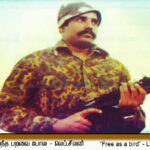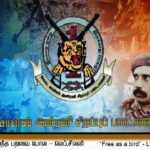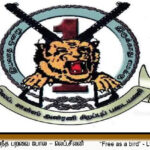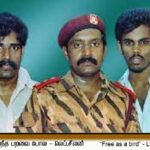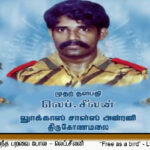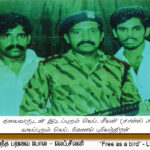

“Free as a bird” – Lt. Seelan
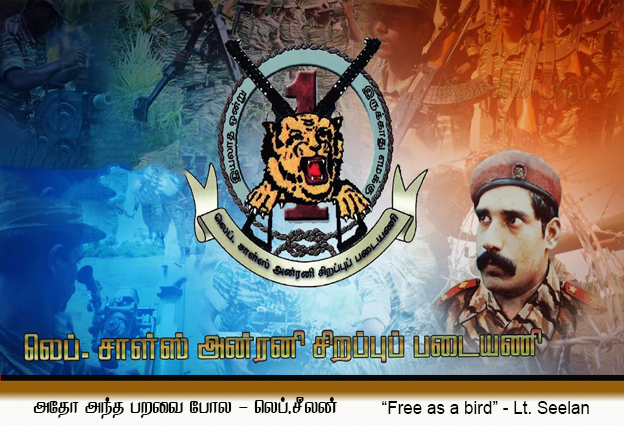
It was 3pm, Friday the 15th July 1983. A pleasant breeze from the Kachai Sea. The village of Meesalai is immersed in peace. Sri Lankan Armed forces surround the small village in a bid to disrupt the peace. Army vehicles are occupying the Allarai Meesalai road which joins Kachai road.
A minibus, two jeeps and an army truck. More than a hundred Sinhalese army task force personnel dressed in plainclothes wrap the village; the village is stunned. Four young men on bicycles with machine guns are rushing through a difficult gravelled road. Realizing a traitor amongst their group had given up their location, they notice the Sinhalese army is surrounding their hideout. In a panic, the four youths cross the Allarai Meesalai road in a bid to escape the village.
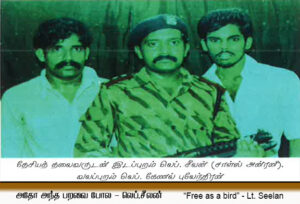 The Military vehicles parked on the road near the crematorium and on the other side near a weaving mill. They rush towards the place where the youths had passed. The youth are rushing out of the army’s firing range. The soldiers from the mini bus disembarked and positioned themselves in safe camouflaged places amongst Palm trees. More than thirty soldiers of the entire group gather inside the palm grove. Unfortunately, the young men who led the chase are now standing in plain sight. The leader amongst the four youths is staring dead into the eyes of the Sri Lankan Army who have surrounded him. He had been given many names, Aseer, Seelan, Ithayachandran but his real name was Lucas Charles Anthony.
The Military vehicles parked on the road near the crematorium and on the other side near a weaving mill. They rush towards the place where the youths had passed. The youth are rushing out of the army’s firing range. The soldiers from the mini bus disembarked and positioned themselves in safe camouflaged places amongst Palm trees. More than thirty soldiers of the entire group gather inside the palm grove. Unfortunately, the young men who led the chase are now standing in plain sight. The leader amongst the four youths is staring dead into the eyes of the Sri Lankan Army who have surrounded him. He had been given many names, Aseer, Seelan, Ithayachandran but his real name was Lucas Charles Anthony.
A hero who stuck his finger in the eye of the Sri Lankan Government forces. Lucas Charles Anthony but better known as Seelan was the head of the military wing of the Liberation Tigers of Tamil Eelam (LTTE). “Shoot!”, the wing commander shouts as his machine gun starts firing. The other three youths rush in and take aim with their guns. Beside the courageous Seelan was Arulnathan whom they called Anand. He, just like Seelan, is also a diamond in both body and soul. In essense Seelan had another hero liked minded as him. They grip into battle with Firmness, composure, speed and grace.
The youth counterattack overwhelms the Sinhalese Army. But the soldiers, cowardly hiding in the midst of palm trees, continue to attack.
They were stuck in a predicament where they could not continue to advance nor retreat, but these individuals are not cowards who’d surrender to the hands of the Government forces! Those who grew up in the arms of Prabhakaran; those who were trained to die with honor than to be captured by the hands of the enemy; those Tigers were brave enough to fight till their last breath. The Army continued to pile up around! Chaos ensued with dust and bullets streaming from end to end. Vision was impaired with both smoke and dust in the air. Seelan’s machine gun continues to rip despite the unfavourable odds! Within moments, the Army’s gunfire rips through his chest. Seelan staggers bleeding heavy. The hero who has bled twice before on the field realizes that he still has some life left.
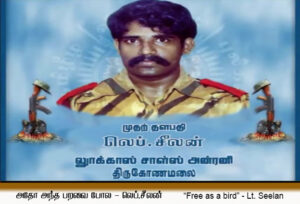 “They’re savage dogs waiting to bite if caught alive! Shoot me and you retreat”, orders Seelan. This is a direct order from the Wing Commander. The commissioned young warrior stands stunned. A constant barrage of rounds come from the pathetic military snuggled comfortably in the Palm grove. Is the death of the beloved comrade? “Do I carry out the order of the Commander Seelan or leave him alive to be captured by the enemy?”
“They’re savage dogs waiting to bite if caught alive! Shoot me and you retreat”, orders Seelan. This is a direct order from the Wing Commander. The commissioned young warrior stands stunned. A constant barrage of rounds come from the pathetic military snuggled comfortably in the Palm grove. Is the death of the beloved comrade? “Do I carry out the order of the Commander Seelan or leave him alive to be captured by the enemy?”
With the compulsion to find an answer in a split second, he is reminded again “Shoot me now” – the stern command of Seelan. Blood flowing out the chest, sweat dripping down the face. Ceylon orders again firmly as he staggers.
Confidence is born in the chest of that hero who has been raised in this field. Within moments, gunshots are pouring into Seelan’s head. The Meesalai soil covers the body of the revolutionary hero Seelan.
At that time, Anand with a boastful look is bombarded by the target. Anand is superior – in appearance, in character, in valour.
‘Shoot me too’ – Anand’s request. Blood seals the purity of the LTTE movement. One of the young heroes protects Anand’s dignity. The army mercenaries gasped as two rare rubies fell to the ground in the Meesalai soil. The other two warriors escaped with the guns of their fallen comrades.
Identifying the fallen LTTE members
The Government armed forces were bewildered. They had no photographs of the ‘wanted’ in their possession. One of the majors of that force was approached Seelan’s body; He raises his sarong and looks at his right leg. Five gunshot wounds above knee joint of the right leg. The major shouts loudly. ‘This is Seelan!’
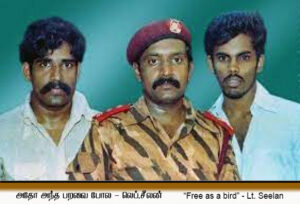 Seelan is a young man just under twenty-three years old, with a handsome face; he is childish in his communication, and he has a charm that attracts anyone. He smiles with a beauty that belongs to him, biting his lip at the corner and narrowing his eyes. People who got to know him were blessed to say the least. He always makes not only himself but also those around him laugh. He is timid in character, but once he warms up to you, he gets along very pleasantly. He knows no hypocrisy. If it means an active attack against the armed forces, he jumps into the field without fear of war and he’d make it look like a breeze. He is a revolutionary who did not sell his soul.
Seelan is a young man just under twenty-three years old, with a handsome face; he is childish in his communication, and he has a charm that attracts anyone. He smiles with a beauty that belongs to him, biting his lip at the corner and narrowing his eyes. People who got to know him were blessed to say the least. He always makes not only himself but also those around him laugh. He is timid in character, but once he warms up to you, he gets along very pleasantly. He knows no hypocrisy. If it means an active attack against the armed forces, he jumps into the field without fear of war and he’d make it look like a breeze. He is a revolutionary who did not sell his soul.
Seelan, like the Tamil Nakieran (an ancient poet) is good at pointing out errors. His thoughts and actions towards a socialist Tamil Eelam were fixed. Seelan had an unshakable belief that Tamil Eelam would be won in the liberation struggle of the Liberation Tigers of Tamil Eelam under the leadership of leader Prabhakaran. He had immense respect for Prabhakaran’s honesty, purity and competence.
The painstaking effort shown by Seelan in maintaining order and control in a clandestine movement while carrying out the armed struggle for national liberation was extraordinary. In that way, Seelan was the article of Prabhakaran’s complete trust and love. Seelan was the foremost among those who stood firmly with Prabhakaran to maintain the integrity of the movement when even the self-interested ones without order and control and the traitors who ran away from the movement engaged in separatist activities and tried to break the pure movement. Seelan laughs at those who fled the movement because of demotion.
The laughter will also be filled with sadness. Seelan was the lifeblood of the movement. Honourable Prabhakaran has done a great job in helping to infuse new blood into the Seelan movement in moments of despair seeing that all the people he believed in were disguised as bureaucrats and selfish. Seelan is not a military person. He has not received military training abroad. His successful guerrilla attacks led by the military wing of the movement added strength to the movement and furthered the liberation struggle.
Seelan is the foremost guerrilla hero in the struggle history of Tamil Eelam. The term ‘General’ is grammar for not only the one who gives orders but also one who leads by example. He worked hard to gather information before launching a guerrilla attack and studies its operations & outcomes. He was also very cautious to ensure that no harm is caused by carelessness. His incredible bravery, keen knowledge of analysing enemy weaknesses and planning accordingly, elevated him to the position of head of an LTTE division in due course.
‘The heroism of a guerrilla fighter is not in his machine gun; It is in his mind’ is Seelan’s words of experience.
His fortitude is immense.
His life is a challenge to death itself.
The first bullet hit him in the chest while giving gun practice. The comrades of the Commander remember the smile on the hero’s face even when he was lying in a pool of blood. The words he choked out, gasping for breath and powerless:
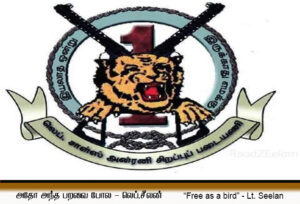 ‘Don’t betray the movement’. Then when he still had time to speak he said: ‘Take the machine gun and put it in safe hands’. Even in his critical condition, the hero’s words about movement are remembered not only with tears but also with pride. It is true. When death finally extinguished the freedom fighter who had defied death, he did not betray his movement; Never fail to place a machine gun in safe hands.
‘Don’t betray the movement’. Then when he still had time to speak he said: ‘Take the machine gun and put it in safe hands’. Even in his critical condition, the hero’s words about movement are remembered not only with tears but also with pride. It is true. When death finally extinguished the freedom fighter who had defied death, he did not betray his movement; Never fail to place a machine gun in safe hands.
Seelan was born and raised in Trincomalee. He witnessed first-hand the practical experiences of Trincomalee, which was entangled in the direct oppression of the Sinhalese racists. Sri Lanka’s planned Sinhalese settlements, oppression by the Navy and Air Force, the warm welcome of the Sinhalese quails, the army, the police and the atrocities that persecute the Tamil people are abundant in Tirumala. Seelan was furious that the Sinhalese deprived Tamils of the land of Trincomalee because of their occupation. Even during his college days, Seelan became a passionate activist against the racist Sinhalese ruling class. On the basis of the Presidential Charter of the Democratic Socialist Republic of Sri Lanka brought in August 1978, Seelan, a school student, came forward to expose the actions taken by the government to celebrate JR Jayawardena’s inauguration as President in Tamil Eelam.
Arrangements were made to hoist the National Flag of Sri Lanka at Tirumala Hindu College on this occasion. Seelan used his own sophisticated knowledge to hide the chemical ‘Phosphorus’ in a coil of their Sri Lankan National flag. When the national flag was hoisted, it was burnt to ashes. Seelan, an 18-year-old student, was arrested on suspicion and tortured by Sinhalese mercenaries. Even at that age he did not betray any of his accomplices. What can prison and torture do to people of principle?
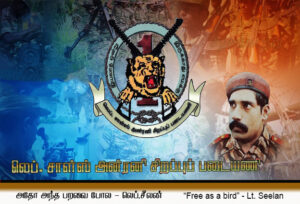 These also taught Seelan the experience that individual resistance cannot destroy the state machinery. It was this experience that served as a driving force for Seelan to involve himself in a revolutionary movement. It was the belief that armed oppression could be overthrown through armed struggle that drew Seelan to the LTTE movement. Until the end, Seelan has lived by believing ‘Tamil Eelam through armed struggle’. Seelan did not have a high-paying career to leave behind before joining the movement. He came from poor family who depended on him for daily meals. Seelan had the great heart and idealism to throw away the expectations of a typical prosperous family life for his country.
These also taught Seelan the experience that individual resistance cannot destroy the state machinery. It was this experience that served as a driving force for Seelan to involve himself in a revolutionary movement. It was the belief that armed oppression could be overthrown through armed struggle that drew Seelan to the LTTE movement. Until the end, Seelan has lived by believing ‘Tamil Eelam through armed struggle’. Seelan did not have a high-paying career to leave behind before joining the movement. He came from poor family who depended on him for daily meals. Seelan had the great heart and idealism to throw away the expectations of a typical prosperous family life for his country.
A small stick hidden by sackcloth; A father without a house, job or permanent income; A mother who keeps the family by cooking; Two brothers; two older Sisters; A younger sister. There were many days when Seelan languished without food. Seelan, who has the ability to think, is saddened to see not only his family but many families languishing in poverty. Seelan’s life was fertile ground for revolutionary ideas. He was deeply involved in Marxist thought. He clearly understood the national and ethnic problem in the light of Marxism.
He was keenly observing the liberation struggles going on all over the world. His views on women’s emancipation were self-reflective, surprising and progressive. The Liberation Tigers of Tamil Eelam (LTTE) movement is proud of the time when Seelan, who had such commendable political skills, worked efficiently as a military unit leader. What Seelan achieved in such a short period of time was enormous. In October 1981, when Brigadier Weerathunga was promoted by the Sri Lankan government and appointed as an army commander, for the first time in the history of Tamil Eelam, he successfully launched a guerrilla attack against the Sri Lankan Army and took down two soldiers.
In 1982, during the visit of JR Jayawardena to Jaffna for the presidential election campaign, the guerrilla operation of destroying the trucks of naval personnel at the Karainagar Ponnalai Bridge was also led by Seelan. Unfortunately, the Sri Lankan Navy mercenaries escaped the attack, but this attack shocked the Sri Lankan government. On October 20, 1982, the fascist fanatic JR Jayawardena was re-elected as the President.
Dawn of October 27th, Chavakacheri
Chavakacheri police station was located a little off the Jaffna-Colombo main road; It includes the charge room, I.U.’s room and police accommodation. A minibus stops just outside the police station. The LTTE, dressed in military uniform from a mini bus, under the leadership of Seelan surrounded the police station with sub-machine guns – SMGs and automatic guns at lightning speed. Two policemen who tried to counterattack were shot.
A series of gunfights erupt, tearing apart the stillness of that early morning. The charge room is destroyed.
A fearless Seelan was targeted by the Police Task Force for his attack in front. Five gunshot wounds were lodged just above the knee joint of the right leg. All the weapons are quickly loaded into the mini bus which were taken from the police station premises. Seelan comes to the mini-bus with his SMG and the enemy’s gun, handing it over to his comrades and staggering; faints.
This is the second injury for Seelan, who was partially recovered after being shot in the chest five months ago during the infamous gun practice.
This gunshot wound greatly weakened Seelan. He was continuously moaning ‘Noguthu, Noguthu’ (Its hurting, its hurting). During the first injury he was given ‘Betadine’ medicine to relieve the pain and Seelan got used to it a little. ‘I cannot bear it’, he says whilst begging for Betadine in pain. He will not lie still; He keeps on going on and on. Once, when a friend who took care of him in the hospital told Seelan to think of God for mental comfort to recover from the pain of his injury, he flatly refused. But next time, when one of his close political friends is caught in a very dangerous situation, Seelan is distraught. Seelan (Charles), a Catholic by birth, climbs the steps of a Hindu temple with a dedication for the recovery of his friend. The passion of his friendship had infused even the thoughts he had grasped in books.
Although he has recovered somewhat, he walks with a limp. In the space of five months, he recovered from the gunshot wounds he received in the chest and leg and acted with confidence.
When he was leaving the hospital after a successful chest injury surgery, the Nurse, who had looked after him lovingly during the days he was in the hospital, asked him. ‘Is it because of your self-confidence that you are healed? Because of friends? Is it because of Doctor? Or by God’s grace?’ Seelan didn’t know what answer the Nurse was expecting. At that moment, friends who were next to her were listening in, waiting for the answer. He wasn’t ready to give her an answer he didn’t agree with and certainly not to disappoint her expectations.
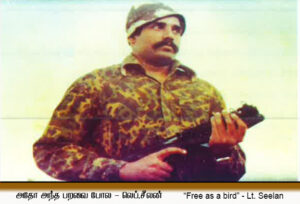 Not even five months after receiving treatment, he again entered the field of struggle in Tamil Eelam. 18th May 1983. The date for the local council elections conducted by the Government of Sri Lanka. Parties steeped in votes by running several campaigns with empty promises. In Jaffna district, the Tamil Liberation Alliance and the United National Party, the Tamil Congress and the Navasam Samaj Party had also embarked on an intense election campaign.
Not even five months after receiving treatment, he again entered the field of struggle in Tamil Eelam. 18th May 1983. The date for the local council elections conducted by the Government of Sri Lanka. Parties steeped in votes by running several campaigns with empty promises. In Jaffna district, the Tamil Liberation Alliance and the United National Party, the Tamil Congress and the Navasam Samaj Party had also embarked on an intense election campaign.
The movement was active in boycotting the local council elections in Jaffna. Seelan was well aware that the Tamil people would not be freed by the opportunistic compromised leaders of the Tamil Liberation Alliance and took the stand to show the Tamil people of their true light. The movement appealed to boycott the election as this election was merely an illusion by the Sinhala chauvinist government, he understood Tamil Eelam would not be achieved by such measly parties in councils. Seelan worked day and night politically and militarily for election campaign work.
The Sinhala fascist leader JR Jayawardena led the UNP. The activities carried out by the LTTE movement on April 29th against the three Tamils who were running on behalf of the United National Party were carried out under the leadership of Seelan. On May 18th, the Sri Lankan government mobilized armed forces across the country for the security of the polling stations. Elaborate security arrangements were made for each polling station. At each polling station, five armed policemen and five armed soldiers were placed on alert for security. Police and army patrolled once an hour.
18th May, 4.15 pm
Near the polling station of Gandharmadam Saivaprakasa Mahavidyalaya, youths on tricycles arrive and alight. Commands are issued by the head Seelan, who dismounts from the bar of a bicycle with a machine gun at dawn. Lanes are blocked and vehicles are diverted. After taking control of the road, Seelan’s attack with these mercenaries was a testament to the bravery of a man who despised death. A Sinhalese writer describes this attack incident and states that ‘people thought that the security forces were not capable of standing and attacking with the LTTE’ and also criticized the LTTE’s military skills. It has been a month and a half since the Gandharmadam incident.
5th of July 1983. It was past midnight.
In Kokuvil, in a house in Thavadi, Seelan sports a Sinhala military uniform for disguise with a machine gun. He knocks on the door and asks the home owner if he could borrow their Mitsubishi Delica Van. He said that they have come from Gurunagar Army Base and that their Jeep is broken at Thavadi Junction. The home owner generously gives his Van.
At around 2.30 am, Seelan and some of his friends stopped the van near the Kangesanthurai (KKS) cement factory and entered the factory with weapons. At gunpoint, they tie up the watchmen and timekeepers at the door and take the keys of the storekeeper. Within five minutes they leave the factory with four large explosive devices and other necessary equipment.
At around 4.30 am, they hand over the Delica van they have received back to the rightful owner. The improvised explosive devices captured by Seelan have contributed greatly to the success of subsequent offensive operations. Unfortunately, Seelan lived only for another ten days from that night.
Seelan, who joined the movement in early 1979, was wanted by state forces since 1981. After this, since there were no photographs of Seelan, who led a guerrilla life in hiding, it was possible for him to carry out political work under different names among the people.
When he was searched by the government forces, he stopped going to his house completely. It was while he was being treated for a gunshot wound to the chest in the hospital that he got the news of his father’s death a few days later. It cannot be said that Seelan wouldn’t have thought how hard his mother would have to work to save the family in the absence of his father. He rarely talks about his family problems with close friends.
Seelan felt that he did not belong only to his Parents. Seelan’s mother was brought from Trincomalee to the Jaffna hospital mortuary to identify his body, stands motionless. She stares at her handsome child, his head maimed by a gunshot wound to the forehead. The son, who had left home four years ago slim in build, is lying in a state of disrepair – a growth – so changed that no identity can be found. The mole, the lips, the face that is trying to show perfection even if it is deformed, she recognizes it.
It is her wealth. She has been looking at him for half an hour. Seelan’s brother is staring at the body next to the grieving mother. A member of the army disturbs the peace.
‘Is this your son?’ – The tearful mother nods.
The mother begs the Major standing there to hand over her son’s body to her. He also spews hatred. “The body of that ‘rich son’ belongs to that mother. That is justice. The body of the ‘liberation hero’ belongs to the government. This is the law.” The terror of the so called ‘moral’ state stifled the right of the poor mother who wanted to honourably bury her son, just because he was a Tamilan.
Seelan was a bigger challenge to the government even in the aftermath of his death. Life of revolutionaries begins only after death. The hospital where his body was kept was under heavy military guard.
After that the mother could not see the body of her heroic son. Seelan’s body, which is shining as an unquenchable fire of revolution in the hearts of millions of Tamil people, was cremated surrounded by military personnel under emergency law without anyone knowing.
Prabhakaran, the LTTE Leader, remembers with tears that hero who lived for freedom;
‘My Seelan is simply Wonderful!’
‘I named him “Ithayachanthiran” (Heart & Moon)!’
‘Why did he leave me so soon?’
‘My heart trembled of the news of his death and I wished that it was not true…’
‘He stood by me as my right hand…’
‘I am grateful for the precious times I spent with him…’
‘He was a very ambitious person…’
‘Why did he suddenly leave us like this?’
‘Again, and again…. like it’s on repeat in my mind – that beautiful face. That gentle smile. His singing of songs. I remember the nights of those days, forest trees rustling, wind blowing, the coals and the firecrackers. We used to have nights where we’d gather and sing songs together, when it comes to Seelan’s turn, it was the main highlight. I’d always shout “That’s Seelan!” As always, a checkered shirt and jeans rolled up above the ankles. He would start of shy. Copes with a smile. But with the encouragement from his friends, he’d get excited and sing majestically! He was met with a rousing reception.’
‘He’d sing with his arms wide open.’ – “You have to live like that bird. You must dance like these waves” “அதோ அந்தப் பறவை போல வாழவேண்டும். இதோ இந்த அலைகள் போல”
We would also like to mention here that the short film ‘Veeraseelam’ was made in his memory.
Commemoration – LTTE Study magazine
முழுமையான கீலே அழுத்தவும்….PFD FILE
![]()
Atho Antha Paravaipola…நெருப்பாற்று நீச்சலில் பத்தாண்டுகள்
